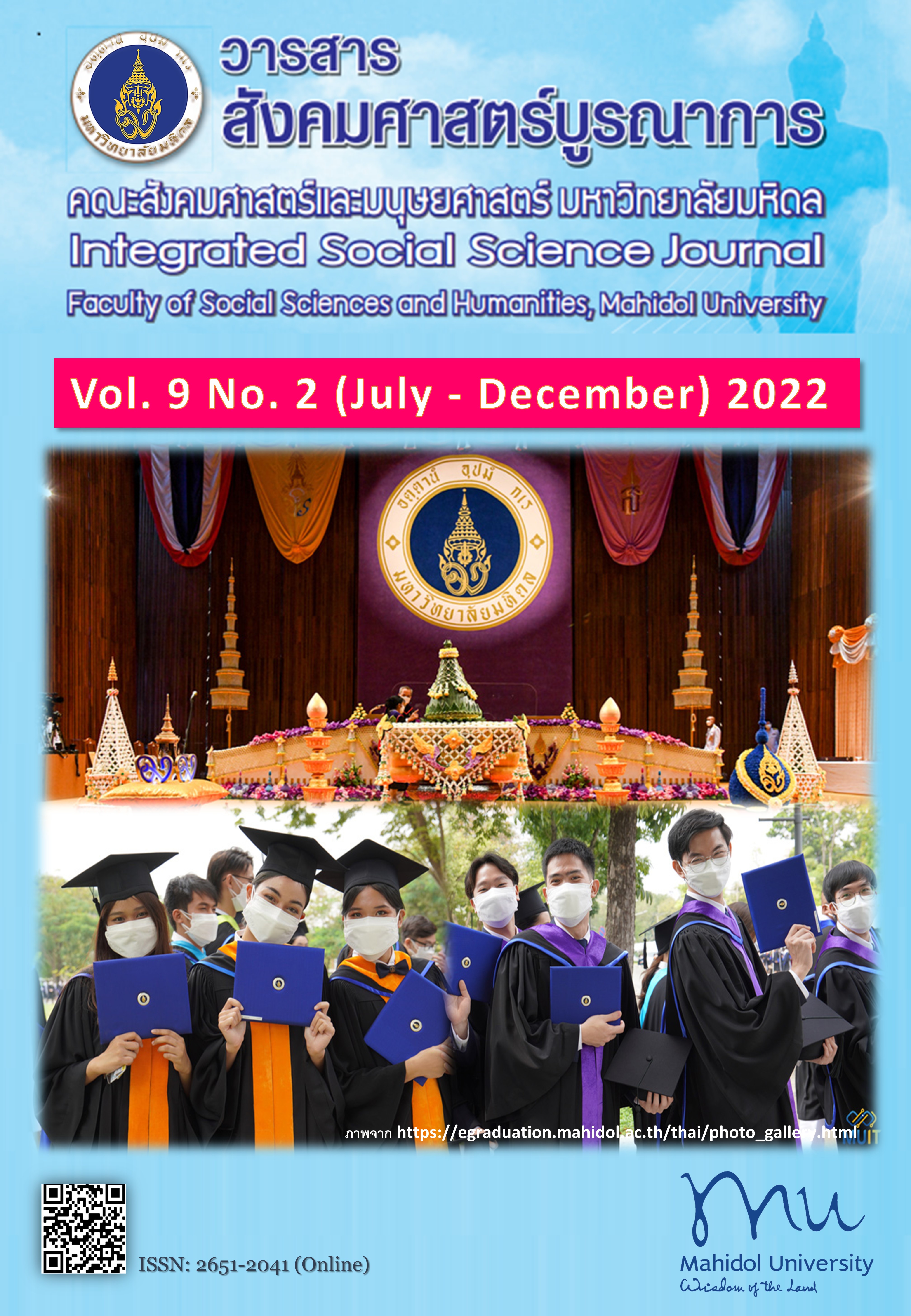การประยุกต์ใช้แนวคิดการทำงานแบบ Agile เพื่อการพัฒนาระบบงาน: กรณีศึกษาสำนักงานผู้อำนวยการ สถาบันชีววิทยาศาสตร์โมเลกุล มหาวิทยาลัยมหิดล
Main Article Content
บทคัดย่อ
การบริหารจัดการภายในองค์การยุคใหม่ที่ต้องการปรับรูปแบบการดำเนินงานให้เกิดความคล่องตัวมากยิ่งขึ้น สามารถก้าวทันโลกที่มีความเปลี่ยนแปลงอย่างรวดเร็วและแข่งขันกับผู้อื่นได้ บทความนี้มีวัตถุประสงค์เพื่อศึกษาแนวทางในประยุกต์ใช้แนวคิดการทำงานแบบ Agile เพื่อการพัฒนาระบบงานของสำนักงานผู้อำนวยการ สถาบันชีววิทยาศาสตร์โมเลกุล มหาวิทยาลัยมหิดล เพื่อเป็นการพัฒนารากฐานสำคัญในการสนับสนุนให้บุคลากรและองค์การ มีความพร้อมรับมือการเปลี่ยนแปลง สามารถปรับตัวเพื่อสร้างสรรค์สิ่งใหม่ ก้าวทันต่อความเจริญก้าวหน้าทางเทคโนโลยี ส่งผลให้พันธกิจประสบความสำเร็จตามเป้าหมาย โดยแนวทางการประยุกต์ใช้เทคนิคการทำงานแบบ Agile ของสำนักงานผู้อำนวยการ จะเริ่มจากการวิเคราะห์ปัญหาและอุปสรรคในการพัฒนาระบบงาน จากนั้นจึงวางแผนกระบวนการพัฒนาระบบงานให้มีประสิทธิภาพ และสร้างวัฒนธรรมการทำงานแบบ Agile ให้เกิดขึ้นภายในสำนักงานผู้อำนวยการ อย่างไรก็ตาม การประยุกต์ใช้แนวคิดการทำงานแบบ Agile เพื่อการพัฒนาระบบงานจะสำเร็จลงไม่ได้ หากขาดปัจจัยสนับสนุนที่สำคัญ อาทิ 1) การยอมรับความเปลี่ยนแปลงของบุคลากร 2) การมีส่วนร่วมจากตัวแทนของทุก ๆ ส่วนงาน 3) การสื่อสารแลกเปลี่ยนระหว่างหน่วยงานที่มีประสิทธิภาพ 4) การให้อิสระทีมงานในการบริหารจัดการปัญหาของตนเอง 5) การกำหนดตัวชี้วัดความสำเร็จที่ชัดเจนและวัดความก้าวหน้าของงานอย่างสม่ำเสมอ และ 6) การพัฒนา “Agile Mindset” คือ การสร้างความคล่องตัวในการทำงาน การตอบสนองที่ฉับไว และการสร้างความพึงพอใจให้กับผู้รับบริการอย่างต่อเนื่อง
Article Details

อนุญาตภายใต้เงื่อนไข Creative Commons Attribution-NonCommercial-NoDerivatives 4.0 International License.
- วารสารสังคมศาสตร์บูรณาการ มหาวิทยาลัยมหิดล อนุญาตให้สามารถนำไฟล์บทความไปใช้ประโยชน์และเผยแพร่ต่อได้ โดยอยู่ภายใต้เงื่อนไขสัญญาอนุญาต CC Attribution-NonCommercial-NoDerivatives 4.0 International (CC BY-NC-ND 4.0) โดยต้องแสดงที่มา/การอ้างอิงจากวารสาร – ไม่ใช้เพื่อการค้า – ห้ามแก้ไขดัดแปลงเนื้อหา
- ข้อความที่ปรากฏในบทความในวารสารฯ เป็นความคิดเห็นส่วนตัวของผู้เขียนแต่ละท่าน ไม่เกี่ยวข้องกับกองบรรณาธิการวารสารฯ (ซึ่งหมายรวมถึง บรรณาธิการ ผู้ทรงคุณวุฒิในกองบรรณาธิการ หรือ บรรณาธิการรับเชิญ) แต่อย่างใด ความรับผิดชอบองค์ประกอบทั้งหมดของบทความแต่ละเรื่องเป็นของผู้เขียนแต่ละท่าน หากมีความผิดพลาดใด ๆ ผู้เขียนแต่ละท่านจะรับผิดชอบบทความของตนเอง ตลอดจนความรับผิดชอบด้านเนื้อหาและการตรวจร่างบทความเป็นของผู้เขียน ไม่เกี่ยวข้องกับกองบรรณาธิการวารสารฯ
- กองบรรณาธิการขอสงวนสิทธิ์ในการตัดทอน/ปรับแก้ถ้อยคำบางประการเพื่อความเหมาะสม
เอกสารอ้างอิง
พุทธิดา สกุลวิริยกิจกุล, กฤช สินธนะกุล, และจิรพันธุ์ ศรีสมพันธุ์. (2563). การศึกษาผลการจัดการเรียนการสอนด้วยระบบการจัดการห้องเรียน PjBL-SCRUM เพื่อส่งเสริมทักษะการทํางานเป็นทีม. วารสารวิชาการครุศาสตร์อุตสาหกรรมพระจอมเกล้าพระนครเหนือ, 11(1), 176–186.
พุธิตา รังสิมันตศิริ และประไพพิศ มุทิตาเจริญ. (2564). กลยุทธ์การสื่อสารภายใต้แนวคิดการทำงานแบบ Agile กรณีศึกษา: หน่วยงานมิราอิ ธนาคารกรุงศรีอยุธยาจำกัด มหาชน. Media and Communication Inquiry, 3(12), 57–71.
สัณหภัค นิลสัย. (2560). การประยุกต์ใช้แนวคิดแบบ Agile กับระบบติดตามและควบคุมความคืบหน้าโครงการ. วิทยานิพนธ์วิทยาศาสตร์มหาบัณฑิตสาขาระบบสารสนเทศเพื่อการจัดการ. มหาวิทยาลัยเทคโนโลยีพระจอมเกล้าพระนครเหนือ.
สมบัติ กุสุมาวลี. (2558). เศรษฐกิจเชิงสร้างสรรค์. สำนักพิมพ์จุฬาลงกรณ์มหาวิทยาลัย.
สถาบันชีววิทยาศาสตร์โมเลกุล มหาวิทยาลัยมหิดล. (2565ก). บุคลากรสายสนับสนุน. http://www.mb.mahidol.ac.th/th/index.php/people-mb/supporting-staff.html.
สถาบันชีววิทยาศาสตร์โมเลกุล มหาวิทยาลัยมหิดล. (2565ข). วิสัยทัศน์. http://www.mb.mahidol.ac.th/th/index.php/about-us/mb-vision.
Bianchi, M., Marzi, G., & Guerini, M. (2020). Agile, stage-gate and their combination: Exploring how they relate to performance in software development. Journal of Business Research, 110, 538–553.
Browaeys, M. J., & Fisser, S. (2012). Lean and agile: an epistemological reflection. The Learning Organization, 19(3), 207–218.
Conforto E. C., Salum F., Amaral D. C., da Silva, S. L., & de Almeida, F. M. (2014). Can agile project management be adopted by industries other than software development? Project Management Journal, 45(3), 21–34.
Denning, S. (2018). The age of agile: How smart companies are transforming the way work gets done. AMACOM.
Fitzgerald, B., Musiał, M., & Stol, K. J. (2014). Evidence-based decision making in lean software project management. Companion Proceedings of the 36th International Conference on Software Engineering, 93–102.
Gundelsby, J. H. (2018). Enabling autonomous teams in large-scale agile through architectural principles. Proceedings of the 19th International Conference on Agile Software Development: Companion, 1–4.
Hoda, R., & Noble, J. (2017). Becoming agile: A Grounded theory of agile transitions in practice. 2017 IEEE/ACM 39th International Conference on Software Engineering (ICSE), 141–151.
Kaufmann, C., Kock, A., & Gemünden, H. G. (2020). Emerging strategy recognition in agile portfolios. International Journal of Project Management, 38(7), 429–440.
Malik, M., Sarwar, S., & Orr, S. (2021). Agile practices and performance: Examining the role of psychological empowerment. International Journal of Project Management, 39(1), 10–20.
Mostafa, S., Chileshe, N., & Abdelhamid, T. (2016). Lean and agile integration within offsite construction using discrete event simulation: A systematic literature review. Construction Innovation, 16(4), 483-525.
Moniruzzaman, A., & Hossain, S. A. (2013). Comparative study on agile software development methodologies. Global Journal of Computer Science and Technology, 13(7), 5–18.
Overhage, S., & Schlauderer, S. (2012). Investigating the long-term acceptance of agile methodologies: An empirical study of developer perceptions in Scrum projects. Proceedings of the Annual Hawaii International Conference on System Sciences, 5452–5461.
Pandkar, S. D., Narkhede, D. E., & Chandane, D. M. (2015). Agile project automation. Journal of Business and Management, 17(8), 50–55.
Putnik, G. D., & Putnik, Z. (2012). Lean vs. agile in the context of complexity management in organizations. The Learning Organization, 19(3), 248–266.
Sharma, S., Sarkar, D., & Gupta, D. (2012). Agile processes and methodologies: A conceptual study. International Journal on Computer Science and Engineering (IJCSE), 4(5), 892–898.
Sliger, M. (2008). Agile project management and the PMBOK guide. Sliger Consulting.
Tam, C., da Costa Moura, E. J., Oliveira, T., & Varajao, J. (2020). The factors influencing the success of ongoing agile software development projects. International Journal of Project Management, 38(3), 165–176.


